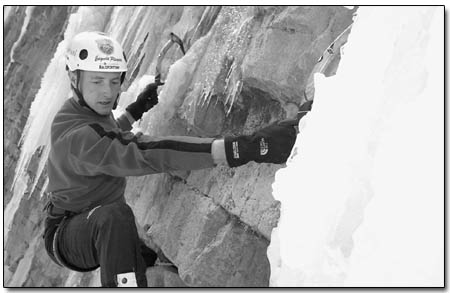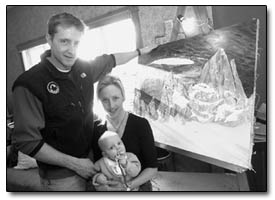|
Durango resident pushes climbing
envelope
written by Missy Votel
 |
|
Jared Ogden dials in a mixed route in
Cascade Canyon, north of Durango, last week./Photo
by Dustin Bradford
|
You’re dangling a thousand feet in
the air on a platform barely the size of a twin bed with
a cold slab of granite for a headboard. You’re cold
and wet, and have been wearing the same clothes for days;
maybe weeks. You try to start your campstove for the daily
ration of ramen, but the sideways rain and wind thwart
your efforts. Darkness sets in, and your uncooperative
cracked, cold hands fumble the lighter. Too tired to retrieve
it, you give up and slink into your soggy sleeping bag.
Buffeted by sleet and wind, you attempt to shiver off
to sleep.
Welcome to the world of big-wall climbing – where
every day is a sufferfest and only the strong survive.
And being a smart ass never hurts either.
“Probably one of the best assets is being sarcastic,”
said Jared Ogden, world renowned big-wall martyr and free
climber. “In the middle of the worst situation,
you usually start cracking up, and that laughter is what
gets you through.”
That and something Ogden calls “retrospective pleasure.”
“A lot of times when I’m in the middle of
something awful, I think about the future and how nice
it’ll be when it’s done, and I can look back
and say, ‘Oh my gosh, look at what I’ve done.’”
 |
| Jared Odgen at home
with his wife, Kristin, and their 10-month-old son,
Tobin. Behind Ogden is a painting he is working on
of the Fitzroy Massif. The former Fort Lewis College
art student paints in his spare time./Photo by Dustin
Bradford |
Apparently the approach works. Since beginning his climbing
career about 13 years ago, the 31-year-old has pioneered
hundreds of first ascents, including a 4,000-foot assault
on the north face of Pakistan’s Nameless Tower in
1995 and a 1996 ascent of Baffin Island’s Polar
Sun Spire. He also won two gold medals in ice-climbing
at 1997’s X-Games and successfully summitted Pakistan’s
remote Shipton Spire. Along the way, he has shared portaledges
with the likes of Mark Synnott, Greg Child and the late
Alex Lowe. His feats have been immortalized in National
Geographic films and Outside magazine and landed him sponsorships
with La Sportiva and Black Diamond as well as a spot on
the prestigious North Face climbing team.
Perhaps Ogden’s greatest technical accomplishment
was his 1999 ascent of the nearly 6,000-foot northwest
face of Pakistan’s Great Trango Tower, believed
to be the biggest wall on Earth. The feat, which he undertook
with longtime climbing partner Synnott and Lowe, has been
called the greatest big-wall climb – and sufferfest
– ever. The face’s sheer size and 20,500-foot
summit, coupled with a perilous approach beneath a hulking
glacier that regularly sends down house-sized chunks of
rock and ice, had earned it a reputation as a “death
route.” However, after weathering 36 days of storms,
hypothermia, exhaustion, a mysterious intestinal illness,
a 50-foot fall, 1,000 pounds of gear, falling rock that
left Lowe unconscious and a 48-hour retreat in a tempest,
the team returned successful.
 Despite
all this, the climber, who lives in Durango with wife,
Kristin, and 10-month-old son, Tobin, remains remarkably
grounded for an icon in a sport that in recent years has
seen a surge in popularity thanks to the commercialization
of extreme sports and the rise of reality television. Despite
all this, the climber, who lives in Durango with wife,
Kristin, and 10-month-old son, Tobin, remains remarkably
grounded for an icon in a sport that in recent years has
seen a surge in popularity thanks to the commercialization
of extreme sports and the rise of reality television.
Ogden admits it wasn’t always this way. After his
first taste of success in Pakistan, he said he was hungry
for more.
“I got back and started getting sponsorships, and
there was a story about it in the Alpine Journal,”
he said. “It gave me a taste of what I wanted, and
I wanted more.”
Ironically, it was the Trango expedition – which
arguably would be the coup de grace for any professional
climber – that proved to be Ogden’s big-wall
swan song.
“It was the media bonanza of the century,”
he said.
In addition to being filmed for an NBC special, the climb
was simulcast over the Internet on the now-defunct San
Francisco-based sports Web site, Quokka.com. Via daily
graphics, maps, photos and e-mails, armchair climbers
could make a virtual ascent alongside their heroes. And
although it was a plausible idea in concept, Ogden said
what sells to the masses doesn’t necessarily make
for a safe or successful climb.
“(Quokka) didn’t comprehend the amount of
work it would take for us to do what they wanted,”
he said. “Basically, we were taking orders from
this geek behind a desk in San Francisco.”
Added to this were the demands placed on the climbers
by North Face, which footed half the bill.
“Those trips cost a lot of money, and since North
Face was paying for half, they had a say, too,”
he said. “It snowballed out of control.”
According to Ogden, the hype and greed left such a bad
taste in his mouth that it affected his love for big-wall
climbing.
“It complicated things to the extent that it tainted
my experience,” he said. “It intruded on our
purpose. We were there to go climbing, to try to do something
for the sport, and all this media crap weighed us down.
“Pretty much since then I quit doing those big-wall
climbs.”
But this isn’t to say Ogden, at what was possibly
the height of his career, turned his back on the sport.
Rather, the experience, coupled with the responsibilities
of a new family, caused him to re-evaluate his climbing
career. In a sort of coming of age move, he decided he
was no longer going to climb for someone else, but only
for himself – and leave egos out of it.
“If things seem risky, I’m like ‘Forget
it; it’s not even worth it,’” he said.
“Climbing’s always been a very large priority.
But it’s not like I’m changing the world by
climbing. Having a family has rooted me more than anything
else I can think of.”
Ogden also said he has been humbled by the new generation
of climbers pushing the limits of the profession.
“The ’90s spawned a whole generation of extreme
athletes,” he said. “Before it was kind of
these fringe characters, and now there’s serious
people who train and are so much more talented. Things
are being climbed that are harder and sketchier and so
out there that it’s a little incomprehensible.”
And with the higher stakes comes more money.
“Kids are getting paid more than I do,” he
said. “I’m over the hill, some people would
say.”
But a look at Ogden’s recent endeavors shows he
is still very much on the hill. Recent expeditions include
a 2000 trip to Mount Jannu in Nepal, where Odgen, Synott
and Kevin Thaw were beaten back by 10 feet of fresh snow
and massive Himalayan avalanches. In 2001, he and Synott
summitted Alaska’s Moose’s Tooth, only to
get lost in a storm and nearly die on the descent. July
of 2002 was spent in Tibet, and December of 2002 was spent
in Patagonia, where Ogden and fellow Colorado climber
Topher Donahue put up two new routes.
Looking ahead, he has three different trips in the works
(which one he takes will depend on sponsorship funding)
as well as this weekend’s Ouray Ice Festival. And
further in the distance, he has his eye on several more
unclimbed peaks – the lure of which proves too strong
for Ogden to resist.
“First ascents are my favorite,” he said.
“Climbing them is like total anarchy. And the cool
thing is that no one’s shown you the way. You are
making your own way and doing it the way you want. It
is total freedom.”
|

